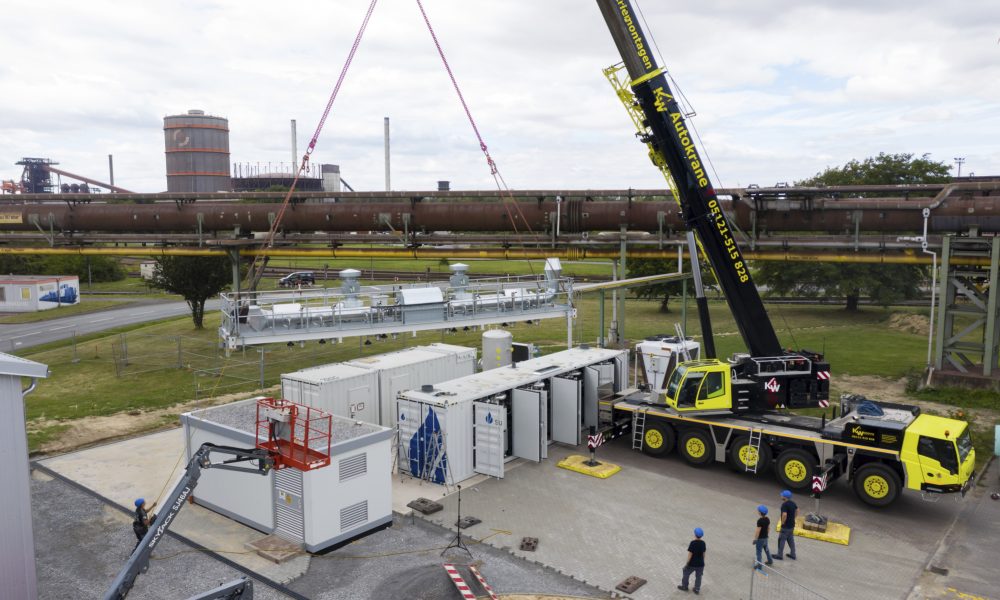A proposal to cut greenhouse gas emissions by producing green hydrogen gas and blending it into natural gas for consumers in Eugene could come with record costs.
If approved, about 2,500 customers of NW Natural, the state’s largest natural gas utility, would begin receiving natural gas with 5% hydrogen gas by early 2024.
The company says the goal is to experiment with creating its own emissions-free hydrogen to make its fuel cleaner in the future. Some experts say greener natural gas could play a larger role in future energy supplies. But the costs of producing the hydrogen are far greater than the costs of electrifying homes and powering them with emissions-free solar and wind energy. Each ton of emissions cut would cost three times the next most expensive method that exists, which is to suck carbon from the atmosphere using large machines, according to the International Renewable Energy Agency.
Environmentalists are skeptical and concerned about the plan. They say it is a way for NW Natural to delay a transition away from natural gas and that the fuel does not have a place in a zero-emissions energy economy of the future. Natural gas is almost entirely methane, one of the most potent greenhouse gases, and it can trap up to 25 times the heat of carbon dioxide in the atmosphere. Utilities watchdogs say the high costs of creating hydrogen to blend into natural gas don’t justify the benefits, and they are concerned that the company will pass those costs to customers.
Green hydrogen
Green hydrogen starts with water, which is made up of hydrogen and oxygen. Using a device called an electrolyzer, an electric current is passed through the water, causing a reaction that splits the hydrogen and oxygen from one another. The hydrogen is captured and stored. The production process requires a lot of electricity. But as long as that electricity comes from a renewable source, such as wind or solar power, the hydrogen is “green” and carbon neutral. Hydrogen emits no carbon dioxide or greenhouse gases, just water.
The Eugene Hydrogen Project
NW Natural is proposing to lease land from the west Eugene facility of the Eugene Water and Electric Board to build a 1 megawatt electrolyzer which separates water into hydrogen and oxygen. The board will provide NW Natural with water and electricity from 90% renewable energy sources to power the electrolyzer and to create the hydrogen. It’s considered green because the electricity would come from renewable sources, and the hydrogen would be produced from water. There are no emissions in the process of making the hydrogen. The hydrogen is then trapped and used as energy, which is emissions-free. The company would blend 5% hydrogen with its natural gas and pump that to about 2,500 customers in west Eugene.
This would be the first such project in Oregon as it joins Washington in attempting to be a national hub of green hydrogen production.
The company hopes to offset the costs of the electrolyzer, which could run up to $10 million, and the cost of creating the hydrogen with state and federal subsidies. It says the project is an experiment as it prepares for a future of more and cheaper hydrogen in the energy sector.
The project is in the early stages of the permitting process with the Public Utilities Commission, according to Kandi Young, a spokesperson for the three-member, governor-appointed commission.
The group regulates the state’s investor-owned natural gas utilities, which include NW Natural, Cascade Natural and Avista.
Young said NW Natural still needs to present its proposal, which would be followed by staff testimony and a public comment period. The deadline for a decision would be in early February 2023 unless the company files for an extension.
Opportunity for NW Natural
The company is not trying to create a low-cost alternative to natural gas or to reduce NW Natural’s overall emissions right now, according to spokesman Dave Santen.
“This initial project – the first in Oregon – will provide valuable learnings that will prepare for the deployment of clean hydrogen more broadly across the economy and sectors,” company spokesman Dave Santen said in an email.
Incorporating hydrogen into its natural gas supply could help the company reach emissions reductions goals mandated by Gov. Kate Brown’s 2020 executive order on climate change.
Those goals include getting the state’s overall greenhouse gas emissions down to 45% of 1990 levels by 2035 and 80% below 1990 levels by 2050. The natural gas sector will be responsible for 26% of those reductions.
Santen said it’s also an opportunity for the company to work with renewable electricity providers on energy storage. When a solar facility has a surplus of energy, it could send electricity to the Eugene facility to make hydrogen. When it’s dark and more electricity is needed, the hydrogen that was made and stored could in turn be used to generate electricity.
“This project will reduce emissions as it enables the creation of low carbon, renewable hydrogen gas that will offset the use of traditional natural gas,” Santen said.
Emissions reductions
The project faces challenges when it comes to proving it’s an effective way to reduce greenhouse gas emissions.
By replacing 5% of the natural gas currently going to 2,500 customers in Eugene with green hydrogen, NW Natural would cut about 200 metric tons of carbon dioxide from being emitted per year, according to Santen.
That represents about 0.003% of the company’s annual emissions, which were about 5.4 million metric tons in 2020, according to the most recent data from the Oregon Department of Environmental Quality.
The average American home and business that relies on fossil fuels for heating and cooking is responsible for about 8 tons of carbon emissions each year, according to an analysis from the nonprofit research group Rocky Mountain Institute, headquartered in Colorado. If those homes and businesses were powered by renewable sources like solar and wind energy, their emissions would be about zero.
Switching 2,500 households in Eugene to renewable energy rather than blended natural gas would have the potential to cut about 20,000 tons of carbon dioxide from being emitted per year. That’s 100 times the amount that would be cut by using NW Natural’s hydrogen and natural gas blend.
Environmentalists say green hydrogen can be a beneficial alternative fuel for large-scaled industrial processes that require a lot of energy, as well as for planes and trains and ships. But they don’t think blending small amounts of hydrogen into natural gas is a beneficial use or efficient emissions reduction strategy.
Nora Apter, climate program director of the nonprofit Oregon Environmental Council, said companies are trying to avoid acknowledging that the “writing is on the wall,” for natural gas.
“The fossil gas industry across the board and in Oregon is digging in its heels as far as figuring out how it can maintain the status quo and continue business as usual. They’re saying, ‘Where can we redirect our fossil gas as this economy is turning away from fossil fuels.’”
NW Natural does not have plans to completely end natural gas distribution in the future.
Cost comparison
Eugene Water and Electric Board will sell the water and electricity to NW Natural at market rates and NW Natural will have to pay for creating the hydrogen, which is more expensive than costs associated with natural gas.
Considering its capital and operational costs, the company estimates that each metric ton of carbon dioxide saved from entering the atmosphere by substituting some hydrogen for natural gas would cost about $3,000.
This would make it among the most expensive ways to limit carbon emissions. The only method more expensive uses machines to suck carbon from the air, which costs about $1,000 per ton of carbon captured.
To pay for the hydrogen, Santen said, rates would go up about 0.2% for residential customers, or about 15 cents per month, and about 0.5% for industrial customers.
“We plan to allocate costs and the environmental benefits across our Oregon customers (not just Eugene),” Santen said.
He said NW Natural is also hoping to offset costs with state and federal subsidies. To incentivize companies to take on challenging renewable energy projects, the Public Utilities Commission offers to cover some costs. In August, the federal government passed the Inflation Reduction Act, which included a tax credit for hydrogen produced with renewable energy.
Without the potential for those subsidies, the company would not consider this project, Santen said.
He said the company would pass those savings back to customers. It estimates the hydrogen would cost between $3 and $4 per thermal unit. As a comparison, the price of one thermal unit of natural gas from NW Natural in Oregon right now is just over $1. The average U.S. household uses about 60 to 90 thermal units of gas per month, according to the U.S. Department of Energy.
Poor long-term prospects
Blending natural gas with hydrogen is not a good long-term decision for reducing greenhouse gas emissions, according to a new report by the International Renewable Energy Agency. It found that attempts to blend hydrogen into natural gas grids would drive up energy costs and deliver minimal greenhouse gas reductions. Replacing even 20% of natural gas with hydrogen – four times what NW Natural is proposing to do – would only reduce emissions from natural gas by up to 7%.
This worries Bob Jenks, executive director of the watchdog Citizens’ Utility Board, which represents thousands of Oregon customers.
“This isn’t a good project,” Jenks said. “It’s a waste of money and way too expensive for what you get.”
Jenks said there are better projects on the West Coast when it comes to creating green hydrogen. One of the largest in the country is in Los Angeles, called the HyDeal project, which includes plans to convert up to four natural gas power plants to green hydrogen.
He also points to the recent decision by the Eugene City Council to advance an ordinance that would end new natural gas hookups in houses beginning in June of 2023.
The next step in the NW Natural project is a public hearing to take place sometime this fall.
Oregon Capital Chronicle is part of States Newsroom, a network of news bureaus supported by grants and a coalition of donors as a 501c(3) public charity. Oregon Capital Chronicle maintains editorial independence. Contact Editor Lynne Terry for questions: [email protected]. Follow Oregon Capital Chronicle on Facebook and Twitter.
STORY TIP OR IDEA? Send an email to Salem Reporter’s news team: [email protected].

Alex Baumhardt has been a national radio producer focusing on education for American Public Media since 2017. She has reported from the Arctic to the Antarctic for national and international media, and from Minnesota and Oregon for The Washington Post. She previously worked in Iceland and Qatar and was a Fulbright scholar in Spain where she earned a master's degree in digital media. She's been a kayaking guide in Alaska, farmed on four continents and worked the night shift at several bakeries to support her reporting along the way.









